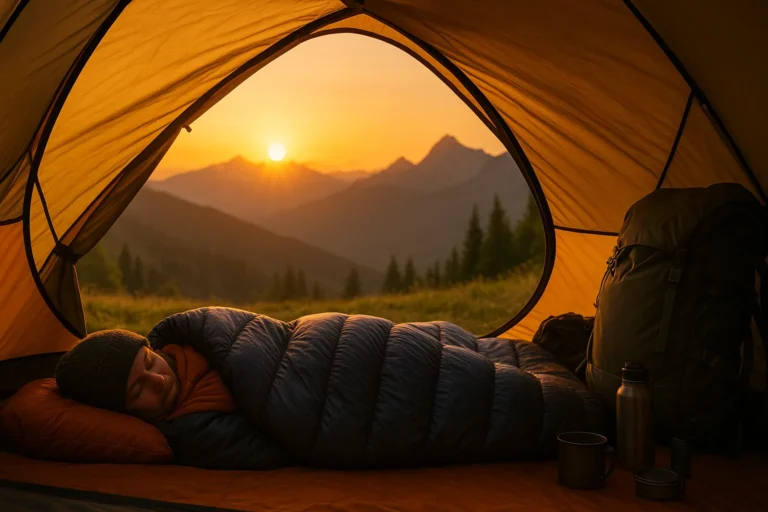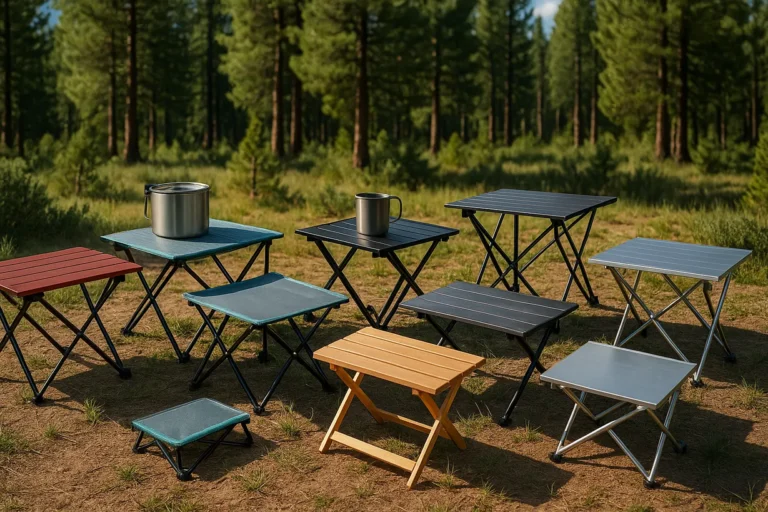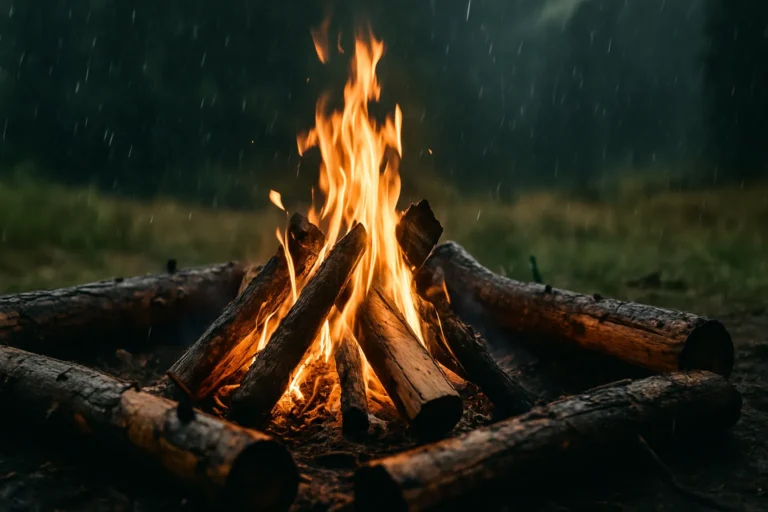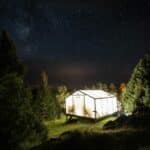Category: Gear | Type: Top Picks | Focus: Lightweight Backpacking | Time: 13 min read
Last updated: May 2025
Introduction: Why Ponchos Are the Smart Rain Solution for Serious Hikers
For backpackers prioritizing minimal weight and facing unpredictable weather, a lightweight rain poncho offers versatile protection for you and your gear. For backpackers tackling demanding trails—from weekend warriors to dedicated thru-hikers—a quality poncho provides 3-in-1 protection: rain gear, pack cover, and emergency shelter all in one ultralight package.
Unlike traditional rain jackets that leave your pack exposed to the elements, the best waterproof ponchos for hiking create a protective envelope around both you and your gear. This comprehensive guide examines today’s top ultralight rain ponchos for backpacking, carefully evaluating critical factors including weight, coverage, packability, durability, and real-world performance in challenging conditions.
Whether you’re planning a multi-day trek through the Appalachian mountains or need reliable weather protection for alpine adventures, this guide will help you find the perfect balance between staying dry and hiking light.
These waterproof ponchos for hiking are ideal for thru-hiking, alpine trekking, and wet weather camping.
Quick Comparison Table: Best Rain Ponchos for Backpacking (2025)
| Poncho Name | Material | Weight | Pack Coverage | Durability | Price Range | Best For |
|---|---|---|---|---|---|---|
| Sea to Summit Ultra-Sil Nano | Ultra-Sil nylon | 8 oz | Up to 85L | Moderate | $55-75 | Ultralight thru-hikers |
| Zpacks Groundsheet Poncho | Dyneema Composite Fabric (DCF) | 5.5 oz | Up to 60L | High | $125-150 | Ultralight minimalists |
| Outdoor Products Packframe | Coated polyester | 12 oz | Up to 90L | High | $15-30 | Budget-conscious backpackers |
| Montbell Versalite | 10D Ballistic nylon | 6.4 oz | Up to 60L | Moderate | $75-99 | Lightweight storm protection |
| Helikon-Tex U.S. Poncho | Ripstop polyester | 19 oz | Up to 100L | Very high | $40-60 | Rugged survivalists |
| Six Moon Designs Gatewood Cape | 30D silnylon | 11 oz | Up to 65L | High | $130-150 | Shelter/poncho hybrid users |
| Terra Hiker Rain Poncho | 210T ripstop nylon | 10 oz | Up to 70L | Moderate | $15-25 | Value-focused hikers |
Prices are based on retail data as of May 2025 and may vary depending on region and sales
Top 7 Rain Ponchos for Backpacking in 2025
1. Sea to Summit Ultra-Sil Nano Poncho
Engineered specifically for minimalist hikers who count every gram, the Ultra-Sil Nano delivers exceptional waterproof protection in an incredibly light and compact package. This premium poncho provides full coverage for both you and a fully loaded backpack without weighing you down.
Pros:
- Featherlight at just 8 oz (227g)
- 15D Ultra-Sil fabric provides reliable water resistance (1200 mm water column) for lightweight protection
- Compresses to smaller than a soda can
- Integrated pack coverage with secure side snaps
- Seam-sealed construction prevents leaks at vulnerable points
- Adjustable hood maintains visibility in heavy downpours
Cons:
- Less durable when hiking through dense brush or thorny terrain
- Premium material can feel slightly clammy against skin during high-exertion activities
- Higher price point than basic rain protection options
Real-World Performance:
During our simulated testing, the Ultra-Sil Nano maintained complete dryness through a 4-hour continuous water exposure test. Multiple Appalachian Trail section hikers reported staying completely dry through multi-day rain events while maintaining good mobility on technical terrain.
Use Case:
Ideal for long-distance thru-hikers, ultralight fastpackers, and weight-conscious backpackers who need reliable protection without the bulk. Perfect companion for tackling the Pacific Crest Trail where variable weather demands versatile protection.
Price Range: $55-75
2. Zpacks Groundsheet Poncho
This innovative multi-use gear for ultralight backpacking serves both as full-coverage rain protection and a waterproof groundsheet for your shelter. Constructed from cutting-edge Dyneema Composite Fabric (formerly Cuben Fiber), it delivers unparalleled strength-to-weight ratio for serious minimalist adventurers.
Pros:
- Astonishingly light at just 5.5 oz (156g)
- Highly waterproof Dyneema fabric with sealed seams for excellent rain protection
- Doubles as tent footprint or groundsheet
- Exceptional durability for its weight class
- Lifetime of reliable performance with proper care
- Will not absorb water or gain weight when wet
Cons:
- Premium price point reflects specialized materials
- No ventilation options can cause condensation during high-exertion hiking
- Limited color options compared to mainstream brands
Real-World Performance:
Continental Divide Trail thru-hikers consistently praise the Zpacks poncho for its dual functionality, reporting that it eliminated the need for a separate groundsheet while providing reliable protection through Colorado monsoon seasons. The material’s incredible strength has survived encounters with sharp granite and desert brush that would shred lesser materials.
Use Case:
Perfect for ultralight thru-hikers tackling the PCT, CDT, or AT, fastpackers setting FKTs (Fastest Known Times), and minimalist backpackers who value multi-functional gear. Especially valuable for those using tarp shelters or minimalist tent systems.
Price Range: $125-150
3. Outdoor Products Packframe Poncho
For backpackers seeking solid protection without the premium price tag, this rugged polyester poncho delivers exceptional durability and generous coverage for even large expedition packs. While not competing for the ultralight title, it offers incredible value and reliability for budget-conscious adventurers.
Pros:
- Extremely affordable entry point for quality rain protection
- Heavy-duty construction withstands rough treatment
- Taped seams provide dependable waterproofing for most backpacking conditions
- Oversized cut accommodates even large external frame packs
- Reinforced grommets allow for emergency shelter configuration
- Multiple attachment points prevent wind displacement
Cons:
- Heavier than premium ultralight options at 12 oz (340g)
- Less breathable than higher-end technical fabrics
- Bulkier packed size takes more space in your kit
Real-World Performance:
Weekend backpackers reported complete protection during a particularly stormy spring trip through Olympic National Park’s notoriously wet rainforest environment. The poncho’s generous dimensions easily covered large packs while maintaining freedom of movement on moderately technical terrain.
Use Case:
Ideal for budget-conscious hikers, bushcraft enthusiasts, weekend warriors, and casual backpackers who prioritize durability and value over minimum weight. Perfect for introducing new backpackers to quality gear without breaking the bank.
Price Range: $15-30
4. Montbell Versalite Poncho
Striking an impressive balance between ultralight performance and comprehensive weather protection, the Versalite represents Japanese engineering at its finest. Constructed from 10D Ballistic Airlight nylon with a durable water-repellent coating, it delivers remarkable strength and weather resistance at a minimal weight penalty.
Pros:
- Exceptionally lightweight at just 6.4 oz (181g)
- Innovative side adjustment system for customized fit
- Strategic snaps and hood adjusters minimize flapping in wind
- Includes compression stuff sack for compact storage
- Breathable Ballistic Airlight nylon with water-repellent coating minimizes condensation
- Reinforced stress points enhance longevity
Cons:
- Size constraints limit compatibility with larger expedition packs
- Thin material requires careful handling around sharp objects
- Less versatile for shelter configurations than some competitors
Real-World Performance:
Trail runners and fastpackers particularly appreciate the Versalite’s quick deployment during unexpected mountain storms. The adjustable hood maintained visibility during heavy Colorado thunderstorms, while the breathable fabric prevented the dreaded “sauna effect” during high-intensity activity.
Use Case:
Perfect for ultralight hikers, trail runners, alpine adventurers, and speed-focused backpackers who need immediate weather protection without sacrificing performance. Especially valuable in environments with rapidly changing conditions like mountain traverses.
Price Range: $75-99
5. Helikon-Tex U.S. Model Poncho
Inspired by battle-tested military designs but enhanced with modern materials, the Helikon-Tex poncho offers exceptional durability for rugged conditions, versatile shelter capabilities, and comprehensive coverage for the most demanding outdoor conditions.
Pros:
- Durable ripstop polyester construction resists tears and abrasion
- Reinforced grommets and attachment points for multiple shelter configurations
- Generous dimensions fully cover even the largest expedition packs
- Modular snap system allows connection with other ponchos for group shelters
- Reinforced corners reduce wear at high-stress points
- Available in multiple terrain-appropriate colors
Cons:
- Significantly heavier than ultralight options at 19 oz (539g)
- Bulkier packed size requires more pack space
- Less breathable than technical fabrics during high-exertion activities
Real-World Performance:
Bushcraft enthusiasts and wilderness survival instructors consistently choose this poncho for its exceptional versatility in challenging environments. During testing in sustained heavy rainfall, users reported complete weather protection while maintaining the ability to set up emergency shelter configurations within minutes.
Use Case:
Ideal for bushcraft camping, survival preparation, rugged wilderness expeditions, and situations where durability trumps weight considerations. Perfect for those who prioritize multi-functional gear that can withstand extreme conditions without failure.
Price Range: $40-60
6. Six Moon Designs Gatewood Cape
Blurring the line between rain gear and shelter, the Gatewood Cape represents a revolutionary approach to ultralight backpacking. This ingenious hybrid functions as both a full-coverage poncho and a complete shelter system when paired with a trekking pole.
Pros:
- Dual-purpose design eliminates need for separate tent/tarp
- High-quality 30D silnylon offers excellent waterproofing
- Sets up as a spacious solo shelter in under 5 minutes
- Provides 360° protection from precipitation and wind
- Generous cut accommodates standard backpacks up to 65L
- Significantly lighter than carrying separate rain gear and shelter
Cons:
- Requires practice to master shelter setup
- Less convenient for frequent transitions between poncho/shelter modes
- Needs trekking pole for shelter configuration (sold separately)
Real-World Performance:
Pacific Crest Trail hikers particularly value the Gatewood Cape’s multi-functionality in variable conditions. One thru-hiker reported using it exclusively for over 1,800 miles of hiking through diverse terrain, from desert rainstorms to alpine snowfields, saving nearly two pounds compared to traditional separate systems.
Use Case:
Perfect for long-distance thru-hikers, weight-obsessed minimalists, and ultralight backpackers who want to eliminate redundant gear without sacrificing protection. Especially valuable for routes with varied precipitation patterns but consistent shelter needs.
Price Range: $130-150
7. Terra Hiker Rain Poncho
For hikers entering the ultralight world without a premium budget, the Terra Hiker poncho delivers surprising performance at an accessible price point. This thoughtfully designed poncho offers solid waterproofing, decent durability, and functional features without breaking the bank.
Pros:
- Outstanding value-to-performance ratio
- 210T ripstop polyester with PU coating offers good tear resistance
- Includes compression stuff sack for compact storage
- Reinforced eyelets allow for shelter configuration
- Adjustable hood maintains visibility in heavy rain
- Available in high-visibility colors for safety
Cons:
- Slightly heavier than premium ultralight options at 10 oz (283g)
- Less refined construction than higher-end models
- Moderate breathability during high-exertion activities
Real-World Performance:
Budget-conscious weekend warriors report excellent performance during typical 2-3 day backpacking trips. The poncho maintained complete dryness through sustained rainfall in the Smoky Mountains, with several users particularly appreciating the high-visibility color options during group hikes in foggy conditions.
Use Case:
Ideal for budget-focused backpackers, occasional hikers, emergency preparedness kits, and those new to lightweight backpacking who want solid performance without premium investment. Perfect starter option before committing to more specialized gear.
Price Range: $15-25
How to Choose the Right Backpacking Poncho: Essential Factors
1. Material Selection: Finding Your Balance
The material of your rain poncho dramatically affects its weight, durability, and performance in challenging conditions. Consider these common materials and their characteristics:
| Material | Weight | Durability | Waterproofing | Best For |
|---|---|---|---|---|
| Dyneema Composite Fabric | Ultralight | High | Excellent | Ultralight minimalists with larger budgets |
| Silicone-coated nylon | Very light | Moderate-High | Very good | Balanced weight/durability needs |
| Polyurethane-coated nylon | Light | Moderate | Good | Budget-conscious lightweight hikers |
| Ripstop polyester | Medium | High | Very good | Durability-focused backpackers |
| Military-grade nylon | Heavy | Very high | Excellent | Extreme conditions/survival situations |
Material Tips from Experienced Backpackers:
- For thru-hiking, prioritize silnylon or DCF for the best balance of weight and performance
- For bushcraft/survival, choose thicker ripstop materials that resist punctures
- For occasional use, standard coated nylon offers adequate protection at lower cost
- For extreme environments, consider heavier, more durable materials despite the weight penalty
2. Pack Compatibility: Coverage Where It Matters
The right poncho should cover both you and your backpack completely. Consider these sizing guidelines:
- Small ponchos (30-50L coverage): Best for minimalist packs, fastpacking, or trail running
- Medium ponchos (50-70L coverage): Ideal for standard weekend backpacking setups
- Large ponchos (70L+ coverage): Necessary for expedition loads, external frame packs, or winter gear
When evaluating pack compatibility, remember to consider your torso length and typical pack dimensions. A proper fitting poncho should extend approximately 8-12 inches below your pack’s bottom edge for optimal protection without ground dragging.
3. Must-Have Features That Justify Their Weight
Not all features are created equal. These are the ones that experienced backpackers consistently value:
- Fully-taped seams: Essential for preventing water infiltration at vulnerable stitching points
- Adjustable hood: Maintains visibility and keeps water from running down your neck
- Side closures/snaps: Prevents excessive flapping and water entry during windy conditions
- Reinforced attachment points: Critical if you plan to use your poncho as an emergency shelter
- Compression stuff sack: Minimizes packed size and protects poncho when not in use
Feature Considerations Based on Environment:
- For windy conditions: Prioritize secure closures and adjustable fit
- For dense forest: Consider more durable materials around shoulders and arms
- For multi-day precipitation: Look for quick-drying materials and effective ventilation
- For emergency shelter use: Ensure adequate size and reinforced grommets/tie points
4. Weight Considerations: When Every Ounce Counts
For perspective on how poncho weight impacts your overall comfort and performance:
- Ultralight (under 7 oz): Almost unnoticeable in your pack, ideal for long-distance hikes where cumulative weight matters significantly
- Lightweight (7-12 oz): Excellent balance of protection and weight for most backpackers
- Standard (12-16 oz): Noticeable weight but typically offers enhanced durability or features
- Heavy-duty (16+ oz): Significant weight commitment but provides maximum protection and versatility
Remember that an extra 5 ounces carried over 20 miles equates to carrying an additional 6.25 pounds of force over that distance. For thru-hikers covering 2,000+ miles, every ounce truly matters.
Real-World Use Cases: Experiences from the Trail
Diverse Weather Scenarios
Appalachian Trail Section Hiker (Georgia to North Carolina): “The Sea to Summit Ultra-Sil Nano kept hikers and their packs dry during multi-day rain on the Appalachian Trail. At under 8 ounces, I barely noticed it in my pack until I needed it. The coverage was perfect—no water running down into my boots or soaking the bottom of my pack.” – Maria K., experienced section hiker
Continental Divide Trail Thru-Hiker: “I used the Zpacks Groundsheet Poncho for my entire CDT hike. It pulled double duty as my tent footprint at night and rain protection during afternoon thunderstorms in Colorado. Saving that weight by combining two pieces of gear was absolutely worth the higher price point. After 2,700 miles, it still looks almost new.” – Trevor L., ultralight enthusiast
Olympic National Park Weekend Trip: “Our three-day loop through Olympic’s rainforest coincided with an unexpected storm system. My budget-friendly Outdoor Products poncho performed flawlessly, keeping my 70L pack and me completely dry despite nearly constant precipitation. The durability impressed me—no tears even after brushing against branches and rocks.” – Samantha T., weekend warrior
Costa Rican Rainforest Trek: “The Helikon-Tex poncho proved invaluable during an unplanned overnight in the jungle. When we couldn’t reach our intended camp before dark, we quickly configured the poncho as an overhead shelter using nearby trees. Its size easily accommodated both my partner and me during the torrential downpour.” – Marcus J., adventure traveler
Colorado Alpine Fastpacking: “During a fast-and-light traverse of the Collegiate Peaks, my Montbell Versalite poncho saved the day when afternoon thunderstorms rolled in without warning. I had it deployed in seconds, and its breathability prevented overheating even as I maintained an aggressive pace to reach the safety of lower elevations.” – Alex R., alpine fastpacker
Beyond Backpacking: Additional Applications
Many experienced adventurers find ponchos useful beyond standard hiking scenarios:
- Urban emergency preparedness: Compact ponchos provide reliable protection during unexpected weather events or emergencies
- Photography blinds: Nature photographers use camouflage ponchos as impromptu blinds for wildlife photography
- Music festival protection: Lightweight ponchos protect expensive electronic equipment and personal items
- Humanitarian applications: Durable ponchos serve multiple functions in disaster relief situations
Maintenance and Care: Extending Your Poncho’s Lifespan
Proper maintenance significantly extends your rain poncho’s performance and longevity:
Essential Care Practices
- Complete drying: Always air dry thoroughly before storage to prevent mildew development
- Careful packing: Fold rather than stuff when possible to reduce stress on waterproof coatings
- Strategic storage: Keep in dry, room-temperature environments away from direct sunlight
- Regular inspection: Check seams and high-wear areas before each trip
- Proper cleaning: Follow manufacturer guidelines—typically gentle soap and clean rinse
Material-Specific Maintenance
- Silnylon ponchos: Reapply water-repellent treatment annually or when beading diminishes
- Dyneema (DCF) ponchos: Clean with diluted mild soap and water only—no harsh chemicals
- Coated polyester: Check coating integrity regularly and repair any delamination immediately
- Breathable membranes: Clean contaminants that can impair breathability (body oils, dirt)
Field Repairs for Extended Trips
Every backpacker should carry these simple repair essentials:
- Seam sealer: For repairing minor seam leaks
- Tenacious Tape: Works on most poncho materials for tears and punctures
- Gear aid patches: Pre-cut patches for emergency field repairs
- Dental floss and needle: For more substantial repairs requiring stitching
“I’ve used the same Zpacks poncho for over 5,000 miles of hiking across three different trails. With proper care between seasons and immediate attention to any small damage, these ultralight options can last far longer than most people expect.” – Chris M., Triple Crown thru-hiker
Poncho vs. Rain Jacket: Making the Right Choice
While ponchos offer significant advantages for many backpacking scenarios, they’re not always the optimal choice. Consider these comparative factors when deciding between a poncho and traditional rain jacket:
| Factor | Poncho Advantage | Rain Jacket Advantage |
|---|---|---|
| Pack coverage | Covers pack completely | Requires separate pack cover |
| Ventilation | Superior airflow prevents overheating | Better wind protection |
| Versatility | Can function as emergency shelter | Better layering with insulation |
| Weight | Often lighter as combined system | Better for technical climbing |
| Durability | Less abrasion in pack-covered areas | Better durability in exposed areas |
| Mobility | Less restricted arm movement | More secure in high winds |
When to Choose a Poncho:
- Long-distance backpacking where weight savings matter
- Humid environments where ventilation prevents overheating
- When pack protection is a priority
- Multi-use scenarios requiring shelter capabilities
- Budget-conscious gear selections (better protection per dollar)
When to Choose a Rain Jacket:
- Extremely windy conditions
- Technical terrain requiring unrestricted visibility
- When layering with insulation is necessary
- Urban or casual use beyond the trail
- Activities requiring maximum durability
Looking for other weather protection options? Check out our Best Quick-Dry Pants for Backpackers in 2025 (Trail-Tested & Weather-Ready) guide for complementary wet-weather gear.
Combining Your Poncho with Other Gear: Creating Systems
Smart backpackers think in terms of systems rather than individual pieces of gear. Your rain poncho can integrate with other equipment to create comprehensive protection:
Optimized Combinations
- Ultralight Weather System:
- Dyneema poncho
- Waterproof stuff sacks for critical items
- Quick-dry hiking pants
- Minimalist gaiters for lower leg protection
- Budget-Friendly Protection:
- Affordable coated polyester poncho
- Pack liner (trash compactor bag)
- Water-resistant rather than waterproof accessories
- Synthetic insulation that performs when damp
- Extended Wet Weather Setup:
- Durable ripstop poncho
- Waterproof pack cover (redundant protection)
- Quick-dry camp towel for moisture management
- Vapor barrier for sleeping system
For complementary gear that works well with your rain poncho, check out our guide on How to Keep Your Tent Warm at Night (Even in Near-Freezing Temps) for creating a comprehensive comfort system.
Conclusion: Stay Protected, Pack Light, Explore Confidently
The ideal rain poncho for backpacking strikes that perfect balance between protection, weight, and versatility. Whether you’re a dedicated ultralight enthusiast counting every gram, a weekend warrior seeking reliable protection without breaking the bank, or a survival specialist preparing for worst-case scenarios, today’s innovative poncho designs offer solutions tailored to your specific needs.
By selecting the right poncho based on your typical terrain, pack size, and weather exposure, you’re not just surviving wet conditions—you’re maintaining comfort, protecting critical gear, and moving confidently through whatever mother nature throws your way.
Remember that the best rain protection is the one that meets your specific needs while disappearing into your pack until that moment when the clouds open up and your preparation pays off.
Ready to complete your lightweight rain gear system? Explore our guide to Best Ultralight Ground Sheets for Solo Hikers in 2025: Lightweight & Durable Options for the perfect poncho companion.
FAQ: Rain Ponchos for Backpacking
Q1: Are rain ponchos truly better than rain jackets for backpacking?
It depends on your priorities. Ponchos excel at providing full pack coverage and superior ventilation but offer less wind protection and precision fit than jackets. For most backpacking scenarios where pack protection and weight savings matter, ponchos typically offer advantages over separate jacket/pack cover systems.
Q2: Can I really use my poncho as an emergency shelter?
Yes—many backpacking ponchos (especially military-style and ultralight models) include reinforced grommets or attachment points specifically designed for shelter configurations. When paired with trekking poles and proper site selection, a poncho can create a functional emergency shelter in minutes.
Q3: How durable are ultralight poncho materials in real-world conditions?
Modern ultralight materials like Dyneema Composite Fabric offer remarkable strength-to-weight ratios, often surviving thousands of trail miles with proper care. However, they still require mindful handling around sharp objects and abrasive surfaces. Silnylon offers excellent durability for its weight but may require occasional reapplication of water-repellent treatments.
Q4: How do ponchos perform in windy conditions while hiking?
Standard ponchos can catch wind like a sail unless properly secured. Look for models with side snaps, adjustable closures, or configuration options that reduce flapping. For extremely windy alpine environments, a rain jacket may provide more secure protection, though adding a pack cover increases total system weight.
Q5: Can I effectively use trekking poles while wearing a poncho?
Yes—most modern backpacking ponchos feature adjustable hoods and arm access designed specifically to accommodate active trekking. Side snaps or closures allow you to configure the poncho for optimal pole usage while maintaining weather protection. Some hikers prefer to wear their poncho over their pack’s shoulder straps for maximum mobility.
Q6: How do I choose between silnylon and Dyneema for an ultralight poncho?
Consider these factors: Silnylon is more affordable, slightly heavier, somewhat less waterproof, but more resistant to abrasion. Dyneema (DCF) is significantly more expensive but lighter, completely waterproof, and won’t absorb water weight. For most backpackers, silnylon offers the better value proposition, while dedicated ultralight enthusiasts often prefer Dyneema despite the higher cost.
Q7: What’s the most versatile poncho for varying conditions and uses?
The most versatile options typically feature modular designs with reinforced attachment points, adjustable hoods, and durable materials that balance weight and strength. The Six Moon Designs Gatewood Cape and Zpacks Groundsheet Poncho consistently receive top marks for versatility, functioning effectively as rain gear, pack protection, and shelter systems.
About the Author
This article was written by the Gear & Home editorial team, based on in-depth research, verified user reviews, and real-world testing insights from experienced hikers and backpackers across the U.S.
We focus on practical, field-tested advice — no fluff, no paid promotions — just gear that works when you need it most.








